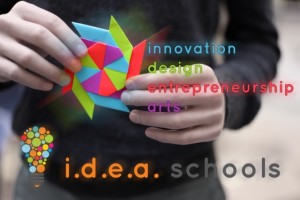
Ari and Oren Mendelow, members of RealSchool, the inquiry-based learning program I began in 2010, now head the I.D.E.A. School Network’s Creativity and Design team. Oren created the origami at the Collaboratory, which Ari then made into a graphic
Collaboratory for PBL in Judaic Studies
Last week was an important one for PBL in Jewish education. On Sunday, March 22, the I.D.E.A. Schools Network held its first Collaboratory for PBL in Jewish education. A group of K-12 educators from schools that included Ben Porat Yosef, Ma’ayanot High School, Magen David Yeshivah High School, Ramaz Middle School, Solomon Schechter Day School of Queens, Westchester Day School, and Yeshivat Noam gathered at one of the Network’s Founding Schools, Magen David Yeshivah High School in Brooklyn, to hash out the challenges of implementing PBL in the Judaic Studies classroom and to begin planning PBL units in Judaic Studies subjects.
Collaboratory: Part I
The first part of the day saw Collaboratory participants explore some of the challenges associated with PBL, which included the following:
I can’t build skills with PBL/Kids don’t have the basic skills in Judaic Studies to do PBL
Students won’t know the “right” story or answer if we open Judaic Studies up to PBL (Corollary: You can be “wrong” in General Studies. You can’t be wrong in Judaic Studies.)
What about learning lishma (for learning’s sake and not for any ulterior motive, such as solving a PBL problem)?
I don’t know what an authentic product is in Judaic Studies.
What about the mesorah, the transmission of ideas and learning that is so important to Jewish continuity? (Corollary: If we change x about the way we learn, the entire edifice of our heritage and mesorah will come tumbling down.)
There’s not enough time. If I do PBL, I won’t finish the sefer, book of Tanakh, or other curricular material I was planning to teach for the year.
Parents/students/other teachers/administrators won’t understand/like this method of teaching. I’m afraid of getting in trouble.
I lack resources. Judaic Studies teachers don’t have the same resources to do PBL that General Studies teachers do.
Each group brainstormed solutions to the challenges presented, but the last one is very true and the reason we were gathered in the light-filled atrium of Magen David: to get started creating PBL resources we can share with the field.
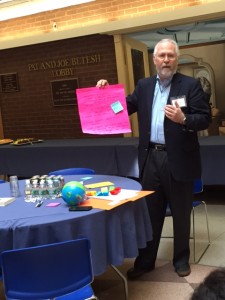
With his “chavruta,” learning partner, Rabbi Mendel Lewitin of Ramaz, Rabbi Saul Zucker, Principal of Magen David, tackled the challenge of how to implement PBL in an environment where one is afraid to do so. Rabbi Zucker shared out a detailed plan of how to unroll PBL to many different stakeholders who may not understand it, such as students, parents, and board members.
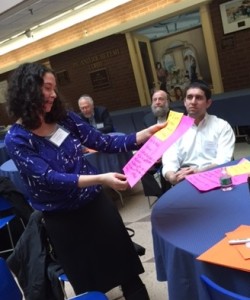
Mrs. Shira Ackerman of Ben Porat Yosef and Rabbi Michael Bitton of Magen David, both Directors of EdTech, talked about the fact that Judaism is a religion of questions — an appropriate point to make right before Pesach. They were answering the challenge of doing PBL in an environment that honors the mesorah and tradition.
Collaboratory: Part II
After facing the challenges of PBL, participants were ready to do some blue sky dreaming about what Judaic Studies could be, using the following prompts as a springboard for discussion:
What are your goals as a Judaic Studies teacher? Is your curriculum aligned with your goals?
How do you learn best?
When do the texts you study affect you most deeply?
Where do you love to study your texts?
Where do you think your students love to study/learn/experience texts?
What do kids really need to know about Judaism?
What do you think kids want to know about Judaism?
One of the most thought-provoking comments about this session came from Mrs. Shira Greenspan of Yeshivat Noam, who attended the Collaboratory with her new baby (mazal tov!) and who had also attended the Summer Sandbox in July. She said when a student asks a question that is off-topic, often a teacher’s response is “Great question. Close your books, and let’s discuss.” Shira said, “Why can’t the response be ‘Open your books. Let’s explore what the texts say.'”
Shira’s comment sparked discussion about making sure Judaism was something kids were connecting to and connecting to the world with. The idea of the student’s having a truly lived experience in Judaism had come up earlier in the day, when Mrs. Shira Ackerman and Rabbi Michael Bitton had discussed what an authentic product in Judaic Studies might be.
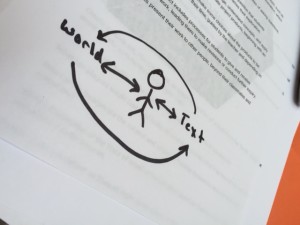
Shira Greenspan’ s comment about making sure texts connect students to the world resonated with all of us. Rabbi Bitton was inspired to create this doodle.
Collaboratory: Part III
After lunch, participants broke into groups to create PBL units.
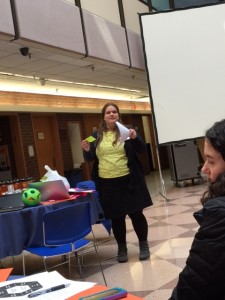
PBL expert of Yeshivat Noam and I.D.E.A. Schools Facilitator Ms. Aliza Chanales walked participants through the components of PBL and pointed out the sample driving questions we had created for the day. (You can find the sample questions below.)
The Collaboratory produced PBL units for Navi, Megillat Esther, Torah, Talmud — thank you to Rabbi Aaron Ross of Yavneh Academy for Skyping in with Rabbis Michael Bitton and Joseph Esses of Magen David and Rabbi Mendel Lewitin, in order to brainstorm ways to implement PBL for Gemara. A Tefillah PBL unit also emerged from the day, arising out of a discussion with Ronit Langer, a RealSchool student who attended the Collaboratory. We had a chance to get student voice on this very important topic, and she told us prayer is punitive in high school and not aspirational. We wondered how we could change that feeling for students.
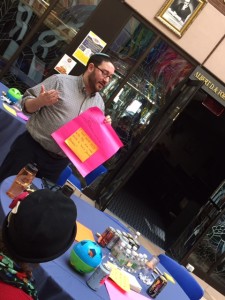
Rabbi Jesse Abelman of Ma’ayanot High School worked on a PBL unit for his class on Yeshayahu (Isaiah). He’s going to ask students to work on what Yeshayahu’s message would be today and introduced multiple modalities into his PBL unit. He already has an Exhibition Night planned, and we can’t wait to hear how it goes!
Here are links to some of the resources we created for the Collaboratory:
Driving Questions for Judaic Studies courses

Stay tuned! Ari and Oren Mendelow will be producing videos on how the PBL units in Judaic Studies are unfolding. We’ll be sure to include both the challenges and successes of PBL in Jewish education
Professional Development Day at Magen David
On March 23, Magen David held a professional development day, which, like the PBL Collaboratory, was a time for teachers to consider how to engage all learners through multiple entry points into and through learning. As my I.D.E.A. Schools partner, Dr. Eliezer Jones, and I have mentioned before, our goal this year is to share out the process of transforming into a school employing PBL, using the experiences of our two schools — Valley Torah High School and Magen David High School (MDY).
This year has seen a lot of MDY teachers working to understand PBL and grasp how to fully adopt it in the classroom. It takes a lot of work to implement PBL and to make sure it’s done well. In fact, the BIE, an educational consulting organization that helps schools implement PBL, is working on creating a gold standard for the pedagogy, since it acknowledges that there are many wrong or incomplete ways to do project-based learning. Magen David has employed a myriad of strategies to enable teachers to become familiar with all aspects of PBL. Much of professional development and ongoing teacher support and training has been devoted to PBL, and a number of administration and faculty members have gone on site visits to various PBL schools across the country and participated in conferences where the pedagogy and other educational innovations have been taught.
PD days in the school have therefore been devoted to sharing the many ideas we’ve gathered. On March 23, Mrs. Roxanne Maleh, an MDY English teacher who visited the High Tech Schools in San Diego, CA, shared best practices she gleaned there. She had learned a tremendous amount from and been deeply inspired by High Tech educator Jeff Robin, whose website she has introduced to the school’s faculty.
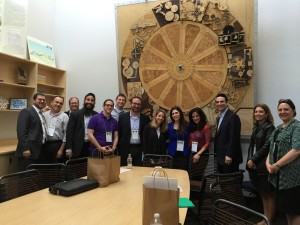
In February, the I.D.E.A. Schools Network hosted a Jewish educators trip to the High Tech Schools in San Diego, CA. Educators from Magen David High School, Shalhevet High School, Valley Torah High School, Yavneh Academy, the Yeshivah Lab School, and YULA Boys High School all had a chance to learn about best practices from a school that’s been doing PBL for 14 years. We highly recommend site visits for schools wanting to learn about PBL and other innovative pedagogies.
We also focused on enabling teachers to learn about digital and visual art tools they could use in the classroom, as a way to engage learners in multiple ways. So for example, Rabbi Michael Bitton and his tech team led an hour-long workshop on creating claymation videos. Here are two:
The school’s art teachers Mrs. Natalie Greenberg and Mrs. Barbara Dweck moved the faculty beyond the tri-board by leading a workshop on creating dioramas using foam core. Educators in the PBL classroom — or, as Jeff Robin calls us, “meddlers in the middle — need to know how to form effective groups and foster collaboration. Ms. Naomi Weiss, who mentors the MDY teachers in various pedagogies, led a session on that topic.
At the end of the day, the MDY faculty divided by department and shared with each other and then with the entire group key takeaways from the day.
Presentations of Learning
The MDY PD day ended deliberately with a sharing out of work and ideas, since public presentation is so key in PBL. A public audience makes learning authentic and creates a drive to produce high-quality work. On Wednesday, March 25, students at Magen David had the opportunity to share their learning in a pre-Pesach exhibit, on Slavery and Freedom, which combined the work of six classes that ranged from the ninth to the twelfth grades.
My sophomore English class researched the history of slavery, as well as current fair and unfair trade practices, enabling students to learn that slavery and exploitation of workers is still very much a problem today.

To represent fair and unfair trade practices today, students “stained and bloodied” clothes to show that companies have manufacturing practices that are abusive and exploitative
Mr. Joe Naftaly’s sophomore history class learned that workers during the Industrial Revolution were also exploited. He had his class create campaigns for political parties that addressed the many problems caused by factory habits in the nineteenth century.
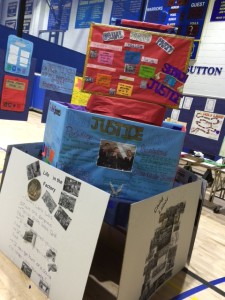
Sophomores in history class created political parties based on horrific working conditions in the 19th century. This “tower of justice” is “based” on problems such as unfair wage conditions and unsafe working conditions.
Mrs. Rachelle Tawil’s freshman Torah class began the part of the exhibit focused on freedom, by asking students how technology enslaves us today and by pointing out that Hashem gave Bnei Yisrael the luchot, the Ten Commandments, as free people, so we would not be enslaved to our desires.
Following Mrs. Tawil’s class’ work was a beautiful visual display of the mitzvoth, the commandments, created by Mrs. Aura Sutton’s and Mrs. Ariella Falack’s junior classes. After each young lady studied the text of a mitzvah she chose to research, as well as commentaries on it, she then created a visual representation of the commandment, using no words. This design challenge produced highly imaginative products! Some young ladies built games, others hacked toys and re-purposed them into mitzvah “machines,” while others produced visually appealing, multi-media artworks.

This “apple juice stand” comes complete with a math equation to help you figure out ma’aser (tithing) for the poor, the widow, the orphan, and the stranger

This artwork — on the laws of the beloved vs. the non-beloved wife — stood out for its impact and clever use of small, three-dimensional details that gave it an almost collage look
The final piece of the exhibit was a culmination of the “We are Here” campaign by Mrs. Falack’s senior class. The campaign started because of Alicia Key’s song “We are Here,” which asks listeners to consider how they can contribute to the world, what they are “here” to do.
The visual display at the exhibit was an international flag and costume show that showed students when we are free, we can be “here” in the world to better it. This part of the exhibit also included an array of chrome books, where students could watch and listen to the videos the senior girls made about why they are here.
Reflection: An Important Part of PBL
In honor of Purim, for the month of March, the YUEducate blog asked us to write about joyful learning. What the summary and pictures of Magen David’s Slavery and Freedom exhibit didn’t capture was the excitement in the air as the students prepared. Though the exhibit topic was a serious one, the students were enthused about their work; as they painted, splattered clothes, 3-D printed frogs, and created a Minute to Win It competition for exhibit-goers — to represent the fact that slaves are rushed to do their work — they were engaged and happy. One sophomore proclaimed, “I love this PBL!” and the night after the exhibit, she texted me an image of a Green Mountain Keurig coffee cup with a fair trade stamp, as well as the headline below, to which she added, “Everywhere I look, something connects to your class and our PBLs.”
Additional reflections included:
“When I learn for a test, I forget the material, but I know I’ll know this next year, because I had to really research the topic and connect it with other classes in order to discuss it.”
“We learn visually and in all different ways, so the information goes in more.”
“When I was painting the clothes, I was thinking about the research I did [on child and slave labor] and it was really going in. When I presented, I found myself talking about the ‘bloodied and stained’ clothes more. . . .”
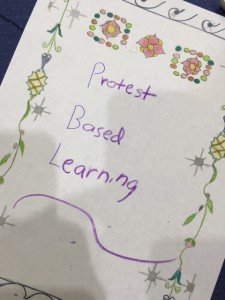
At the end of the exhibit, participants could create their own haggadah page, using student-made templates inspired by Hebrew illuminated manuscripts. One young man said PBL should stand for “protest-based learning,” because the exhibit made him want to protest against slavery and unfair labor practices in the world today!
All is not perfect in PBL land. One young woman added, “I still have issues with time management.”
Sigh. Don’t we all?
Joyful, Experiential, and Inquiry-Based Learning
The point is, the creation of this exhibit was a joyful one, despite the heavy topic, but it was also a meaningful one, which engaged learners using multiple modalities and in ways that were cognitive and affective. How fitting then that we’re discussing it between Purim and Pesach, when we move from the joy of the former to the experiential and questioning mode of the latter. Joy, experience, and inquiry are all deeply embedded in PBL, as they are in the Jewish tradition. What a great week to have discovered that anew.
Cross-posted on yueducate.com









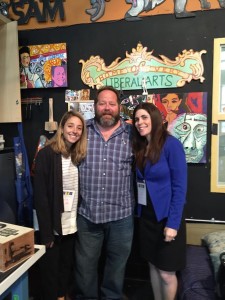
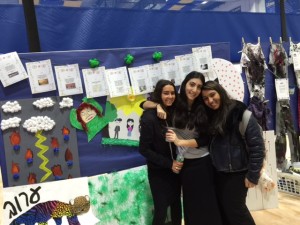
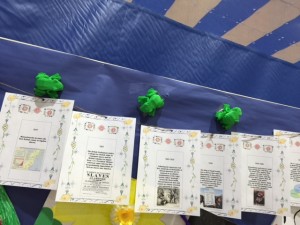
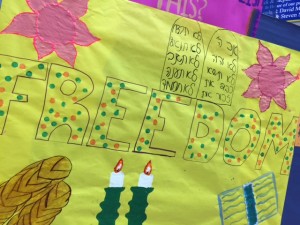
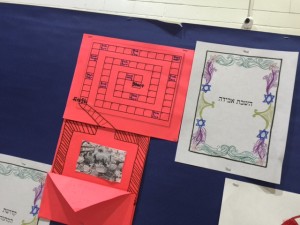
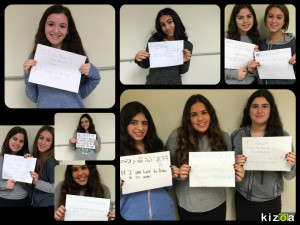
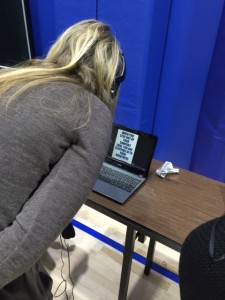
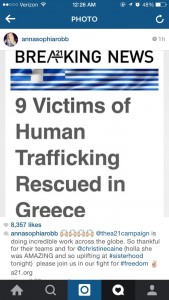



Leave a reply
You must be logged in to post a comment.